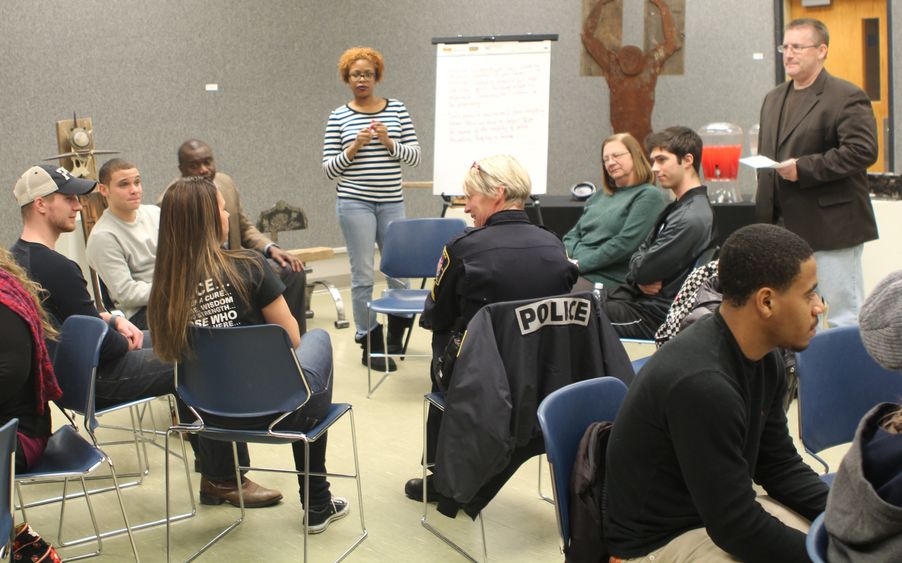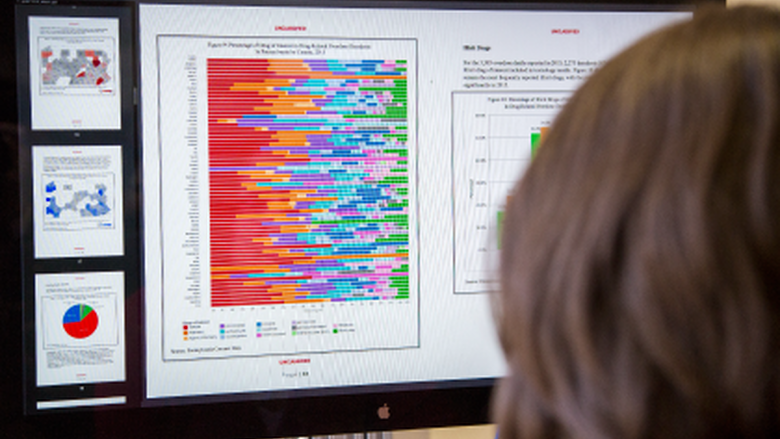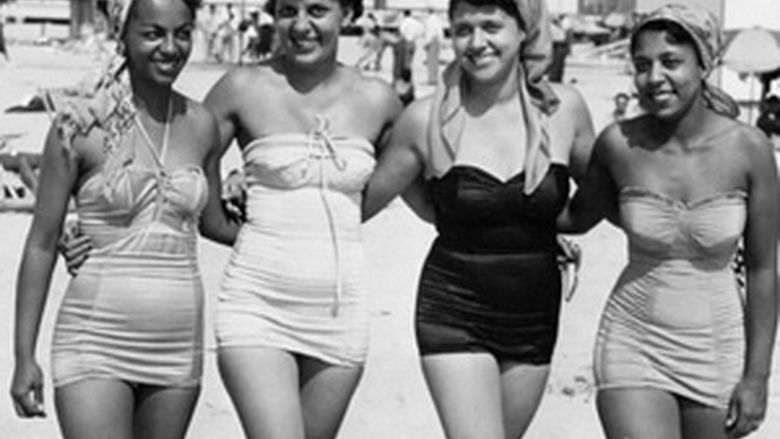
Police officers meet with community members. Penn State researchers have found that more social distance between police and communities results in lower confidence in police, and less social distance results in more confidence.
Penn State Harrisburg School of Public Affairs researchers, Jonathan Lee and Jennifer Gibbs, both assistant professors of criminal justice, say that for police to forge better relationships with the communities they serve, they must decrease “social distance.”
Lee and Gibbs define social distance as the perceived closeness, or lack thereof, one has with the police. Social distance decreases with an increase in informal interactions. The more social distance, they say, the lower the confidence community members have in police. The less social distance, the more confidence.
In a recent study, “Race and attitudes toward police: the mediating effect of social distance,” the researchers assert that widespread research finds that members of minority groups, such as African Americans, have lower confidence in police than whites do. They maintain that social distance may be an important, yet untested, factor. Their paper examines the mediating effect that social distance may have over other factors that affect attitudes, such as race, age, gender, and various interactions with police.
Social distance is not a new concept in social sciences, the researchers said, but it was an important factor in studying public attitudes toward police, especially in an era that focuses on community policing.
“Community-oriented policing is a driving force of 21st century policing in the United States,” said Lee. “Police cannot practically deal with all crime; they need help and support from the public. They cannot earn that support without reaching out to the community in a favorable, amicable way.
“Despite the fact that this has been a highlight of the policing paradigm, we don’t have many measurements of how successfully it has been implemented.”
That is where social distance comes into play. Lee said that social distance factors can help measure how well police agencies are getting out into their communities, talking to neighbors, understanding their situations and plight, and gaining confidence and trust.
And, social distance has the potential to mediate the relationship between race and public confidence in the police, Lee and Gibbs said.
Measuring attitudes toward police
Lee and Gibbs surveyed a random sample of 1,500 Penn State students about various factors such as their contact with police, attitudes toward the police and the students’ lifestyles. A variety of races were surveyed, however, whites made up the majority of respondents (81 percent), so the researchers split race into “white” and “minority.” Gender and age were also included. There were more males (56 percent) than females. The average age in the sample was 21 years old.
They measured confidence in police using indicators including, “how much confidence do you have in the police,” “I am satisfied with the police,” and “the police are responsive to the community concerns in my neighborhood.”
Social distance was measured with three indicators of positive interest and relational distance – “I have at least one police officer among my family members,” “I have at least one police officer among my close friends,” and “I personally know at least one police officer in my neighborhood who is neither my family member nor my close friend.”
Negative contact with police was measured by three indicators asking about individual experience of “unreasonable stops,” “insulting language,” or “physical force” by police officers in the past two years.
The researchers also measured exposure to media coverage of police misconduct, asking how often the respondent heard or read about police use of excessive force, racial profiling, and corruption. More than half of the respondents reported they had heard or read such coverage.
The survey also measured criminal victimization, with most students indicating that they had not been a victim of crime in the last two years.
Lee and Gibbs found that race, coupled with negative contacts and exposure to media coverage of police misconduct, was the only significant demographic factor, with minority respondents having lower confidence in police than white respondents. Minority students also showed more negative contacts with police, more negative vicarious experiences, and more exposure to media coverage of police misconduct. Males had more negative contacts with police than females.
Negative contact and vicarious experience appeared to decrease confidence in police.
The researchers then added social distance to the model and found that there was no difference in confidence in police among white and minority students. While minority students reported less familiarity with police than white students, greater social distance equaled lower confidence in police no matter the race.
The researchers found that greater social distance had a significant diminishing effect on confidence in the police but that race became no longer significant if that social distance gap is closed, proving that social distance is a mediating factor in the relationship between race and confidence in the police.
“The further apart people felt from police, the lower the confidence they had in the police,” Gibbs said. “At that point, race didn’t matter, what mattered more was whether or not you had a personal relationship with a police officer.”
Lee and Gibbs say that closing the social distance gap may help decrease crime and increase citizen obedience to police. They suggest that police focus efforts on improving police-public relations through community policing.
Changes in policing can narrow social distance
Gibbs asserts that among other things, militarization of police has created a growing social gap between the police and citizens, encouraging citizens to ignore police directives and disrespect the police. Also, when police view a greater social distance between themselves and the public, they perceive the public as more dangerous, which can affect their interactions with the public and further undermine this relationship.
“In the 1990s, community policing emerged as a popular response to the rising crime rates resulting from the crack cocaine epidemic,” Gibbs said. “In 2016, in the era of homeland security, police have become more militarized and have moved away from community relations.
“Police must become more socially close to the public. This can be as simple as a handshake and giving a business card. When police are out meeting people where they live, everyone is more trusting.”
The researchers suggest that similar federal, state and local programs, such as Teen and Police Service Academy and Citizens’ Police Academy, are concrete ways to apply the principles of community policing while promoting closeness. They also suggest additional training on procedural justice, ensuring fair process to all citizens who interact with police.
“When citizens think they are being treated fairly and are receiving respect from police, they may believe, by extension, they are of a similar social status as police to deserve such treatment, thereby increasing closeness between the public and the police,” said Gibbs and Lee.
Actions as simple as changing the long, varying work schedules for police may allow them to develop social relationships with citizens outside of work, thus decreasing social distance between the police and the public, the researchers said.
The researchers added that there are some limitations to the study, including the sample of students was drawn from students at one university and that these results may or may not reflect the views of other college-age students or the U.S. population as a whole.
“Ideally, this type of study was supposed to be implemented in a public setting, not a college setting,” Lee said. “We are using this study as a pilot and moving it to the public for a more accurate look at attitudes toward police.”
The researchers are currently conducting the survey in Swatara Township, Pennsylvania, sponsored by the School of Public Affairs. Lee, is also conducting a survey in Harrisburg, Pennsylvania as a part of a federally funded pilot program with Harrisburg police and Tri-County Community Action.





